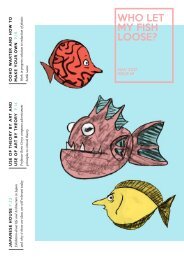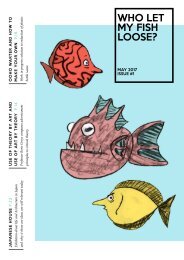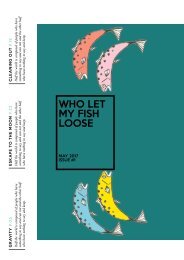*updatemag
Create successful ePaper yourself
Turn your PDF publications into a flip-book with our unique Google optimized e-Paper software.
Issue #1<br />
Who let my fish loose?<br />
in contemporary architecture, and their<br />
focus is the cinematic exploration of contemporary<br />
architecture. Through the film<br />
Moryama-San, we follow the touching story<br />
behind Ryue Nishizawa’s masterpiece.<br />
The story went something like this: After<br />
his mother has died, our protagonist, Mr.<br />
Moriyama wanted to tear down their family<br />
house and build a new one, so he wrote<br />
a letter to the architect. “You don’t need a<br />
house, you need your own village”- said the<br />
architect.<br />
A small village inside a forest<br />
The Moriyama house itself is an archipelago<br />
of ten units. These can be used<br />
by the resident himself, or, rented out.<br />
Ryue Nishizawa focuses on creating the<br />
environment that fits within the existing<br />
landscape. In the suburbs where<br />
Mr. Moriyama resides, everybody has<br />
known each other for dedicates, and<br />
the street is often used as a shared<br />
communal area. Nishizawa wanted to<br />
create an unrestricted part of this landscape<br />
that is still unique. He does not<br />
use fences, and uses large transparent<br />
windows and even a glass corridor in<br />
one of the blocks, in order to not create<br />
isolation from the natural landscape,<br />
as well as the communal feeling of this<br />
Tokyo neighbourhood. He also highlights<br />
the importance of soil in a concrete<br />
city like Tokyo. Having soil in his<br />
garden, allowed Moriyama to keep one<br />
of his mothers trees after her passing,<br />
and also use the trees for the utilities<br />
they provide, often using them for drying<br />
his clothes.<br />
We see the intimate, organic relationship<br />
between the house and it’s<br />
inhibitor unfold in a dainty, spontaneous<br />
film by the iconic duo Ila Bêka<br />
and Louise Lemonie, also known as<br />
“Bêka&Lemonie”. Bêka and Lemonie<br />
are considered to be the cult figures<br />
Moriyama-san is a man of exquisite taste<br />
and character. Bêka stumbled into him<br />
spontaneously, and they started talking<br />
about music, which resulted in mr. Moriyama<br />
inviting him to the basement of his house<br />
where he kept his extensive record collection<br />
(parts of which can be found scattered<br />
around the exhibition units) and they<br />
bonded over their liking of Otomo Yoshihide,<br />
one of the pioneers of “noise music”<br />
which Moriyama is very fond of. There is a<br />
line in the film that explains that Moriyama<br />
likes music and film, but he loves reading.<br />
Much of the film is spontaneous, but it is an<br />
interesting, unique portrait of a man and<br />
his house, which seem to have become one.<br />
They cannot exist without each-other. The<br />
visitors feel the closeness and seem to be<br />
very touched by Moriyama’s character. It is<br />
interesting to be able to get to know a man’s<br />
character based on his home. The film features<br />
shots of small collectable sculptures,<br />
that are also displayed in the exhibition<br />
which only intensifies the feeling of familiarity.<br />
This is why, it can be said that Moriyama<br />
House is not a building. It is an immaterial<br />
and material portrait of the man and his<br />
spirit coming together in perfect balance<br />
with the surroundings that make this building<br />
Moriyama’s home, and an absolute architectural<br />
masterpiece.<br />
23






